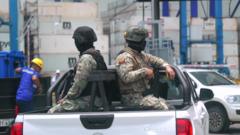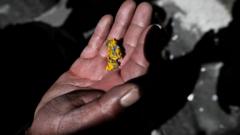Ecuador has increasingly become a central hub for cocaine trafficking to Europe, primarily due to demand from drug-consuming nations. This article explores the dynamics of the trade, its violent implications, and the call for international accountability.
Tracking the Rising Tide of Cocaine Trafficking from Ecuador to Europe

Tracking the Rising Tide of Cocaine Trafficking from Ecuador to Europe
Ecuador's burgeoning role in the global cocaine trade is fueled by European demand and perpetuated by violent gangs.
Cocaine, once primarily associated with Colombia and Peru, has found a new route through Ecuador, drawing the attention of the Albanian mafia, one of Europe’s significant drug trafficking organizations. Criminal elements in Ecuador have been leveraging the country’s strategic ports, which have become the conduits for an alarming increase in global cocaine exports. In recent years, threats and extortion have proliferated as mafia groups gain control over the supply chains.
Ecuadorian President Daniel Noboa has highlighted that despite not producing any cocaine, a staggering 70% of the world's cocaine exports now funnel through the nation. Drugs arrive from Colombia and Peru and are then concealed within legitimate cargo, commonly bananas, to evade law enforcement scrutiny—an unsettling reality pointed out by industry figures like José Antonio Hidalgo, who notes that bananas make up nearly two-thirds of Ecuador's shipping containers to Europe.
As authorities crack down on this illicit trade, the consequences of its violence are devastating. The drug smuggling operations have led to a spike in homicides, with January 2025 witnessing 781 murders attributed to disputes among gangs. Local drivers, like Juan (named for anonymity), recount chilling experiences of unwittingly transporting drug-laden shipments or facing threats for refusal to comply with criminal demands. The widespread fear is palpable; failure to cooperate with the Albanian mafia could lead to dire repercussions.
The police, under Major Christian Cozar Cueva, face a daunting challenge as they combat traffickers employing more sophisticated methods of concealment and export. Approximately 300 tonnes of drugs were seized last year alone, reflecting a worrying growth in exports underpinned by spiraling European consumption rates.
Data indicates that cocaine use in Europe, particularly in the UK, is at record levels, prompting significant profits for organized crime groups. The UK market alone, valued at £11 billion annually, fuels the cycle of production and violence in Ecuador, leaving local communities to bear the brunt of deteriorating safety and economic hardship.
The demand in European markets, highlighted by a recent report from the UK Home Office indicating a 7% rise in cocaine consumption, points to an insatiable appetite that lends itself to the expansion of drug trafficking networks. Despite law enforcement efforts, tackling the root of the problem involves addressing consumer behavior in affluent countries. The ramifications of the trade are felt not only among those involved directly but also throughout Ecuadorian society, as local economies are threatened by the reputational damage associated with drug trafficking.
President Noboa’s administration places significant emphasis on military involvement to stem gang-related violence and seeks international assistance for a more robust response to the drug crisis. His remarks serve as a stark reminder that the violence inherent in the cocaine trade is often displaced from the consumers in Europe to vulnerable communities like those in Ecuador. As the situation escalates, stakeholders urge for a reevaluation of consumer responsibility in combating the global cocaine crisis.



















